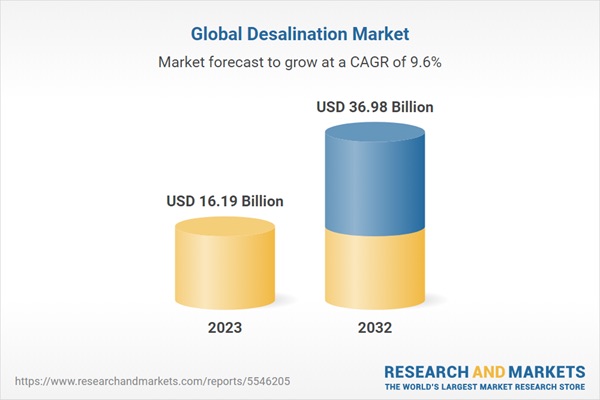Global Desalination Industry Research 2024: A USD36.98 billion Market by 2032 ResearchAndMarkets.com
The Global Water Desalination Market size is expected to reach USD36.98 billion by 2032, up from USD16.19 billion in 2023, with a CAGR of 9.61% from 2024 to 2032, according to ResearchAndMarket.com.

Communities are increasingly using desalination strategies to obtain essential water assets by purifying wastewater, brackish water, and saltwater. This method is broadly employed to reap sparkling water for agricultural and human use. Desalination occurs evidently as a part of the water cycle, wherein rain is created through the evaporation of seawater, leaving salt in the back of the clouds. While seawater desalination has been used for centuries on boats and submarines to provide fresh water during long voyages, large-scale desalination vegetation was no longer developed until the Industrial Revolution.
As per study by researchers at the United Nations University’s Institute for Water, Environment, and Health (UNU-INWE), approximately 16,000 desalination plants are in operation globally, spanning 177 nations, collectively generating about 95 million m3/day of clean water. The Perur plant in India is anticipated to be finished by December 2026, and it will increase Chennai’s water delivery through 400MLD.
Newly water desalination plant projects worldwide
Apr 2023: Three USA initiatives are under construction, which include the Antioch Brackish Water Desalination mission, the City of Camarillo North Pleasant Valley Desalter venture, and the City of Santa Monica Brackish Desalter Production Efficiency Enhancement project.
Saudi Arabia announced seven new desalination projects to be built starting in 2024: Ras Alkhair 2, Ras Alkhair 3, Tabuk, Alshuqaiq, Rabigh 5, Rayis 2, and Jazan.
May 2024: The Government of St. Kitts and Nevis built a water desalination plant at Canada Estate. Canada obtained solar-powered water desalination plants from the United Arab Emirates as a part of the UAE’s Caribbean Renewable Energy Fund (CREF).
January 2024: South West Water made an investment of GBP125 million in a desalination plant on the West Coast of the United Kingdom. The plant will have a capacity of 20,000 m3/day and will offer water for 300,000 human beings in Cornwall. It is expected to meet up to 40 percent of the location’s water demands.
Cannes Mandelieu desalination plant aims to supply fresh water to the Alpes-Maritimes region. This state-of-the-art facility is designed to incorporate energy-efficient processes and minimize environmental impact, setting the standard for future desalination projects in France.
Oct 2023: Hydro announced an investment of EUR3 million to install a new water treatment plant at its Schwandorf legacy site in Bavaria.
China plans to build seawater desalination projects in several provinces and cities with the goal of producing 3 million cubic metres of freshwater daily by 2030, requiring USD10 billion in investments.
India has announced plans to build Asia’s largest desalination plant in Chennai to address saline groundwater intrusion.
Saudi Arabia water desalination market
Thanks to the increasing investment in desalination, Saudi Arabia is at the forefront of the global water desalination market. The 4th MENA Desalination Projects 2023 Report has revealed that the total expenditure on proposed or ongoing regional desalination projects amounts to USD39.3 billion. Saudi Arabia and the United Arab Emirates are the leading investors in these nations, with USD14.58 billion and USD10.28 billion, respectively. In 2019, around 60% of the Kingdom’s water supply came from desalination, most of which was provided by the government-owned Saline Water Conversion Corporation (SWCC).
- Saudi Arabia uses desalination to convert salt water from the Red Sea and the Persian Gulf into fresh water.
- Desalination is criticized for its environmental impact due to its reliance on gas and oil.
- Saudi Arabia aims to achieve net-zero emissions by 2030 and is taking steps to reduce carbon emissions, such as using solar panels at desalination plants.
- Large-scale solar power desalination, such as at the Jazlah plant, is contributing to significant carbon emission savings.
- The growing demand for solar desalination is driving the water desalination industry.
Six largest desalination plants worldwide
- Ras Al Khair Plant, Saudi Arabia has a capacity of 1,036,000 m3/day.
- Sorek Plant, Israel has a capacity of 624,000 m3/day.
- Shoaiba 3 Expansion, Saudi Arabia with a capacity of 550,000 m3/day.
- Jebel Ali M Station, United Arab Emirates has a capacity of 140,000 m3/day.
- Shuweihat S1 Hybrid Plant, United Arab Emirates has a capacity of 454,000 m3/day.
- Ras Azzour, Saudi Arabia, with a capacity of 380,000 m3/day.
